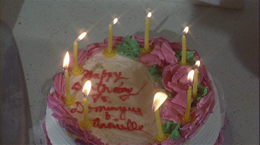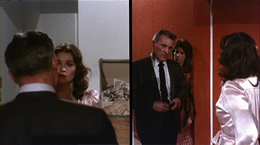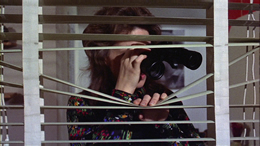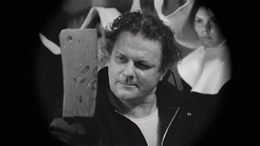
Color, 1973, 92m.
Directed by Brian De Palma
Starring Margot Kidder, Jennifer Salt, William Finley, Charles Durning, Dolph Sweet, Lisle Wilson
Arrow (Blu-ray & DVD) (UK R0 HD/PAL), Criterion (DVD) (US RA/R1 HD/NTSC), Fox (UK R2 PAL), Wild Side (France R2 PAL) / WS (1.75:1) (16:9)

 Greetings and Hi, Mom!, he didn't become the gleefully manipulative, flamboyant cinema maestro film fans came to know and love until Sisters, one of the best American International offerings from the '70s. In a pattern which soon continued through his other thrillers and horror films, De Palma adopted many Hitchcock trademarks into his own style, often involving quirky location details, split screen sequences, amusing pokes at gender and racial stereotypes, and startling flourishes of sex and violence.
Greetings and Hi, Mom!, he didn't become the gleefully manipulative, flamboyant cinema maestro film fans came to know and love until Sisters, one of the best American International offerings from the '70s. In a pattern which soon continued through his other thrillers and horror films, De Palma adopted many Hitchcock trademarks into his own style, often involving quirky location details, split screen sequences, amusing pokes at gender and racial stereotypes, and startling flourishes of sex and violence.  Grace is infuriated by the police's lack of cooperation. With the help of a private eye (Durning) and her own journalistic training, Grace decides to uncover the truth behind these two twins, who harbor a truly chilling past history.
Grace is infuriated by the police's lack of cooperation. With the help of a private eye (Durning) and her own journalistic training, Grace decides to uncover the truth behind these two twins, who harbor a truly chilling past history.  full-blown horror with a justifiably famous hallucination sequence shot in black and white through distorted lenses. The palpable atmosphere of urban insanity is aided immensely by Bernard Herrmann's jolting, electronic-flavored score, which makes even the opening shots of Siamese twin fetuses creepy and ominous. While the actors are ultimately just pawns in De Palma's devious cinematic game, Kidder and particularly Salt shine with some endearing bits of character acting. Salt's arrival at Emil's house is an especially creepy bit of viewer manipulation, in which a seemingly normal conversation with one of the residents suddenly takes an unexpected turn. While the film feels intense and extraordinarily violent, it's actually quite impressive how very little (paint-like) blood is truly spilled onscreen -- but it really counts when it starts dripping.
full-blown horror with a justifiably famous hallucination sequence shot in black and white through distorted lenses. The palpable atmosphere of urban insanity is aided immensely by Bernard Herrmann's jolting, electronic-flavored score, which makes even the opening shots of Siamese twin fetuses creepy and ominous. While the actors are ultimately just pawns in De Palma's devious cinematic game, Kidder and particularly Salt shine with some endearing bits of character acting. Salt's arrival at Emil's house is an especially creepy bit of viewer manipulation, in which a seemingly normal conversation with one of the residents suddenly takes an unexpected turn. While the film feels intense and extraordinarily violent, it's actually quite impressive how very little (paint-like) blood is truly spilled onscreen -- but it really counts when it starts dripping. with the rest more open to allow greater leeway for projectionists, a tactic repeated with Phantom of the Paradise. In 2000, Criterion issued a DVD presented in anamorphic widescreen at 1.75:1, with those 1.85:1 bits kept as such. Thankfully Criterion decided to keep the grain and preserve the detail, resulting in a solid transfer for the time given the limitations of NTSC; this is one film that doesn't need to look glossy and overpolished. The extras are actually more paltry than you might think from the packaging and Criterion's track record since you just get De Palma's 1973 article on working with Herrmann, which has been quoted and referenced endlessly over the years, and an interview with De Palma which recites much of the same information. In 2005, the same transfer for carried over for a similarly paltry UK disc from Fox.
with the rest more open to allow greater leeway for projectionists, a tactic repeated with Phantom of the Paradise. In 2000, Criterion issued a DVD presented in anamorphic widescreen at 1.75:1, with those 1.85:1 bits kept as such. Thankfully Criterion decided to keep the grain and preserve the detail, resulting in a solid transfer for the time given the limitations of NTSC; this is one film that doesn't need to look glossy and overpolished. The extras are actually more paltry than you might think from the packaging and Criterion's track record since you just get De Palma's 1973 article on working with Herrmann, which has been quoted and referenced endlessly over the years, and an interview with De Palma which recites much of the same information. In 2005, the same transfer for carried over for a similarly paltry UK disc from Fox. 
 section is divided into four new pieces, all HD, first with a great 10-minute chat with Salt, now a producer on American Horror Story. She talks about being college pals with De Palma, rooming in a Malibu house with Kidder (who was dating De Palma at the time and is described as an adventuress), being given the script for Sisters as a Christmas present, experimental theater and film work, and plenty more. Co-writer Louisa Rose also gets a 10-minute piece about her college days with De Palma and the gang as well as her own thoughts on how to build an effective suspense scene and the then-daring color blind casting and Freudian imagery, while editor Paul Hirsch has a longer 17 minutes to go into his own production stories, the film's initial audience reactions, an appropriate observation from Baz Luhrmann, and the comparisons between De Palma and Hitchcock's "sadist" personalities. Unit manager Jeffrey Hayes offers the most arduous account of the production for a 5-minute overview, focusing on the Staten Island locations and how it trained him to learn to be prepared for a movie. Finally there's a 6-minute audio interview with the late Finley, a decades-long friend of De Palma's, in what sounds like a phone conversation about how the film was financed through Ed Pressman (which led to Phantom) and what it was like shooting all of the director's early efforts from his student days. It's also accompanied by tons of photos and advertising art for the film, which is great all by itself. Some of that same material also turns up in a separate international image gallery, complete with very different poster art and lobby cards from around the world. For a really heavy dose of De Palma, Mike Sutton also offers "The De Palma Digest," a 31-minute audio essay (again with tons of images) running through the stylist's influences, recurring themes, and cinematic highlights over the years all the way up through the giddy Passion. Very highly recommended, obviously.
section is divided into four new pieces, all HD, first with a great 10-minute chat with Salt, now a producer on American Horror Story. She talks about being college pals with De Palma, rooming in a Malibu house with Kidder (who was dating De Palma at the time and is described as an adventuress), being given the script for Sisters as a Christmas present, experimental theater and film work, and plenty more. Co-writer Louisa Rose also gets a 10-minute piece about her college days with De Palma and the gang as well as her own thoughts on how to build an effective suspense scene and the then-daring color blind casting and Freudian imagery, while editor Paul Hirsch has a longer 17 minutes to go into his own production stories, the film's initial audience reactions, an appropriate observation from Baz Luhrmann, and the comparisons between De Palma and Hitchcock's "sadist" personalities. Unit manager Jeffrey Hayes offers the most arduous account of the production for a 5-minute overview, focusing on the Staten Island locations and how it trained him to learn to be prepared for a movie. Finally there's a 6-minute audio interview with the late Finley, a decades-long friend of De Palma's, in what sounds like a phone conversation about how the film was financed through Ed Pressman (which led to Phantom) and what it was like shooting all of the director's early efforts from his student days. It's also accompanied by tons of photos and advertising art for the film, which is great all by itself. Some of that same material also turns up in a separate international image gallery, complete with very different poster art and lobby cards from around the world. For a really heavy dose of De Palma, Mike Sutton also offers "The De Palma Digest," a 31-minute audio essay (again with tons of images) running through the stylist's influences, recurring themes, and cinematic highlights over the years all the way up through the giddy Passion. Very highly recommended, obviously.